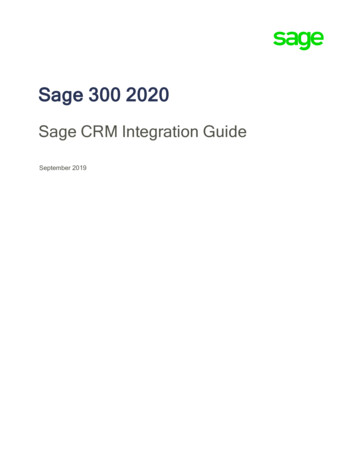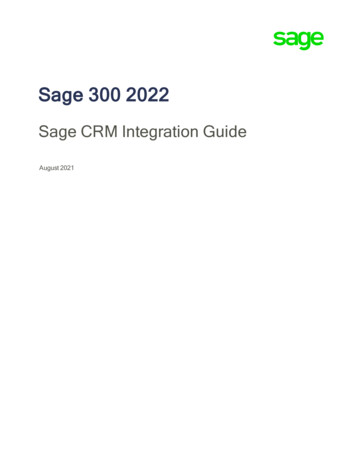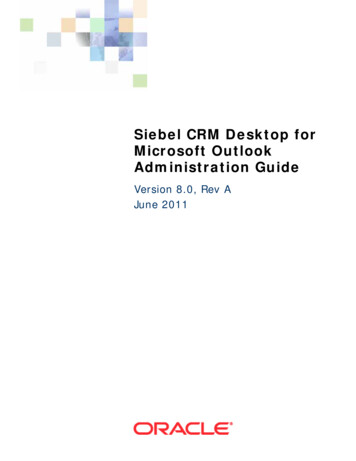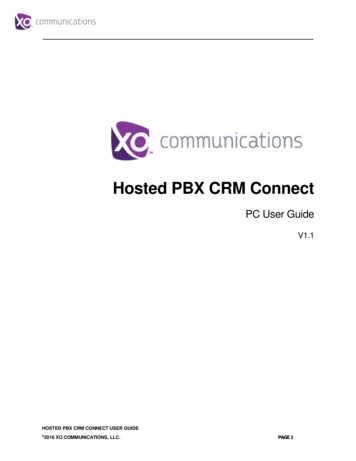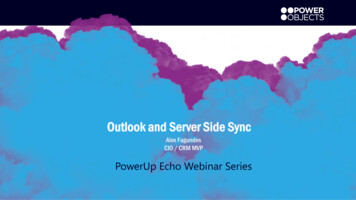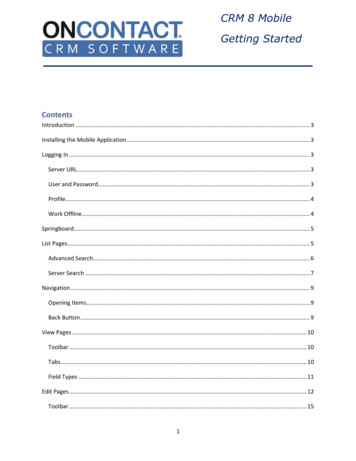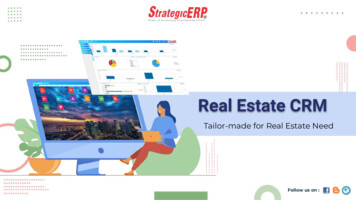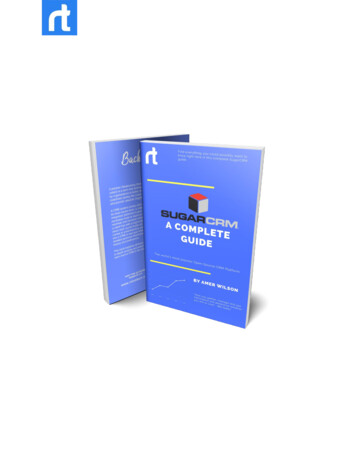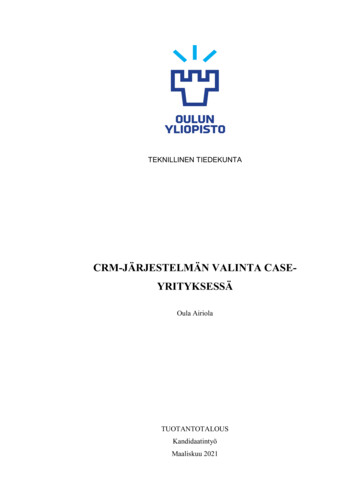
Transcription
2020 International Transaction Journal of Engineering, Management, & Applied Sciences & TechnologiesInternational Transaction Journal of Engineering,Management, & Applied Sciences & Technologieshttp://TuEngr.comPAPER ID: 11A04QEFFECTS OF E-CRM ON THE SERVICE ATTRIBUTESAND QUALITY OF CUSTOMER-BANK RELATIONSHIPa*aMohammad Amin Abdi , Mohammad Reza Hamidizadeh ,aManizheh GharacheaFaculty of Management and Accounting, Shahid Beheshti University, IRAN.ARTICLEINFOA B S T RA C TArticle history:Received 24 June 2019Received in revised form 12August 2019Accepted 16 August 2019Available online 12 December2019This paper investigates the effect of electronic CustomerRelationship Management (e-CRM) on the service attributes andquality of customer-bank relationships, for a study case of MaskanBank Branches in Tehran.This is applied research in terms ofobjective and it is descriptive and quantitative in terms of data nature.The statistical population of this research includes the customers whoKeywords:use the Maskan Bank electronic communication service in Tehran city.Service Attributes;According to results, the implementation of e-CRM affects the servicesRelationship quality;Relationship outcomes; attributes and quality as well as the outcomes of Customer Relationshipwith bank Maskan. In addition, the e-CRM implementation also has anBanking services;indirecteffect on relationships quality and outcomes throughElectronic Customercustomer-based service attributes. This study find that the educationRelationshipand communication duration with bank as an intervening variableManagement; Virtualaffects each of the e-CRM variables, the quality and outcomes ofrelationships;customer-bank relationships.eBanking; eCRM.Disciplinary: Management Sciences (Banking Management). 2020 INT TRANS J ENG MANAG SCI TECH.1. INTRODUCTIONThe relationships management with electronic customers is the result of one of the fundamentalchanges in the business beliefs and paradigms and that change of organizations approach is frommass and general relationships with different customer groups to one-to-one and virtualrelationships with them through IT and communications, which is a kind of trading strategy toincrease the volume of customer financial transactions with the bank. The e-CRM is a customerbased marketing strategy that deals with the most valuable assets of an organization, which is itscustomers. It addresses all customer-related financial and business processes. It creates value bothfor the organization and the customer. Information technology should be used to present this valueand implement this strategy. Therefore, e-CRM can lead to the most surprising evolution of the*Corresponding author (Mohammad Amin Abdi). Email: amin7abdi@gmail.com 2020 International Transaction Journal ofEngineering, Management, & Applied Sciences & Technologies. Volume 11 No.04 ISSN 2228-9860 eISSN 1906-9642 CODEN:ITJEA8 Paper ID:11A04Q http://TUENGR.COM/V11/11A04Q.pdf DOI: 10.14456/ITJEMAST.2020.771
transition from product-driven differentiation to customer based differentiation.Electronic customer relationship applications were developed with e-banking. These types ofoperational programs give organizations the ability to care for their customers through the web andreach customers’ demands on time. This is one of the differences between CRM and e-CRM, whichchanges from service providing-service receiving CRM to web-based CRM. The evolution ofe-CRM has been associated with the e-business that transforms traditional business from massproduction to mass customization.With the emergence of e-CRM, the banks should no longer see the digital advantage ofcustomer relationships as an option, they should consider it an indisputable necessity. Of course, thee-CRM did not obsolete traditional marketing, but empowered it. One of these empowermentmakers is the IT tool that marketers can use to develop an online technology. e-CRM for banks inthis era is considered as a strategic investment. A bank can be successful in having the bestcustomer relationship strategy.2. THEORETICAL FUNDAMENTALS AND RESEARCH BACKGROUND2.1 CRM & eCRMThere are many definitions of CRM. In the definition given by Galbreath and Rogers (1999),CRM is defined as follows: activities undertaken by a company to identify, find, attract, developand maintain the loyalty of profitable customers by providing responsive goods and services tosuitable customers through responsive channels at a reasonable cost and time, CRM facilitatesrelationships between companies and customers, business partners, suppliers and employees.Another definition provided by Hamilton(2001) states: The process of storing and analyzing thevast amount of data produced by the sales calls, customer service centers, actual purchased,supposedly yielding greater insight into customer behavior. CRM also allows the company tobehave differently with a variety of customers. In the other definition provided by Swift (2000),CRM is an enterprise approach to understanding and influencing customer behavior throughmeaningful communications, in order to improve customer acquisition, customer retention,customer loyalty, and customer profitability CRM is a comprehensive strategy and process ofinventory, management and data sharing with key customers to create great value for the companyand customers.As the scholars acknowledge, CRM has five benefits. It simplifies the customers work forexchange transactions, focuses on end-users of products and services of organizations, redesigns theprocesses of dealing with customers, makes the organization profitable, and creates loyalty in thecustomer. The e-CRM application provides profiles and history of every organization's contactmade with its customers, and is a combination of hardware, software, applications, and managerialobligations. Whose goal is to improve customer service, build a relationship and maintain acustomer base. e-CRM does not only include software and technology, but also includes businessprocesses based on a customer- based strategy and includes a wide range of topics, tools, andpractices ranging from the proper design of digital goods to pricing and loyalty programs.The Sweeny Group has defined CRM as “all the tools technologies and procedures tomanage improve or facilitate sales, support and related interactions with customers, prospects andbusiness partners throughout the enterprise.”2Mohammad Amin Abdi, Mohammad Reza Hamidizadeh, Manizheh Gharache
In this research, e-CRM refers to establishing the electronic communication by the customerwith the bank through four communication channels defined in the system, including the bank'swebsite, e-mail, telephone (call center) and mobile.2.2 SERVICE ATTRIBUTESPast research and scientists' views show that there is a big gap between the implementation ofe-CRM and the outcomes that this gap should be addressed by responsive variables. The variablethat fills this gap is called customer-based service attributes. The attributes of customer-basedservices in this research are defined as CRM and e-CRM activities, in other words, as a result ofe-CRM and CRM outcomes in the bank from the customer perspective. Using the information ofexperts and previous studies, the dimensions of customer- based services attributes are presented inTable 1.Table 1: Dimensions of service attributes (Sivaraks et al, 2011)Dimensioninformation provisionAccurate information provisionRelevant information provisionResponsive information provisionInformationTimely access to accurate informationComplete information provision to customerPersonalized information and servicesProvide consistent dataCustomerconvenienceProviding information on the conditions ofservices purchase and useOpportunities to interact with bankCommunicationContact at any timechannelContact at any placeReferencesJutla et al. (2001), Kos et al. (2001), Pan and Lee (2003)Jutla et al. (2001), Kos et al. (2001), Pan and Lee (2003)Jutla et al. (2001), Kos et al. (2001), Pan and Lee (2003)Anton (1996), O'Halloran (2003)Goodhue et al. (2002), Kos et al. (2001)Nykamp (2001), Peppers & Rogers (1993)Goodhue et al. (2002), Peppard (2000)Feinberg and Kadam (2002)Kos et al. (2001), Peppard (2000), Wilson et al. (2002)Boonajsevee (2005)Boonajsevee (2005)Consequently, it forms the overall impression that a customer has concerning the completerelationship with a business, including different transactions (Wong & Sohal, 2002). Relationshipquality comprises several key components that reflect the overall nature of relationships betweenfirms and their customers (Hennig-Thurau et al, 2002).Therefore, in this research, the purpose of the study was to determine the overall quality of therelationship, including the bank's attention to the customer's demands, the importance of therelationship with the bank for the client, the advantage of the relationship with the bank for theclient, the customer's prominence of the relationship with the bank, the bank-customer respect, thebank's flexibility to the customer demands and attention to the customer needs by bank. Also, thepurpose of trust is to maintain customer information by the bank, lack of bank's mistakes inexecuting customer's requests, and the full trust of the client to the bank. The purpose of customersatisfaction includes diversification, quality, speed and desirability of the services provided by thebank, as well as the general customer satisfaction of the bank service. The purpose of thecommitment is to include customer perspective and foresight on its relationship with the bank, thecommitment of the bank to fulfill the customers' demands, and the customer's commitment tocontinue its relationship with the bank. The purpose of loyalty includes the permanent selection ofbank services by the client, the choice of the bank as the main service provider by the customer,perspective and customer investment in the bank and the best choice for the client in the selection ofbank. Also, the purpose of giving advice to others is to offer a bank service by client to his friendsand connecting with friends and acquaintances about the bank's terms and conditions.*Corresponding author (Mohammad Amin Abdi). Email: amin7abdi@gmail.com 2020 International Transaction Journal ofEngineering, Management, & Applied Sciences & Technologies. Volume 11 No.04 ISSN 2228-9860 eISSN 1906-9642 CODEN:ITJEA8 Paper ID:11A04Q http://TUENGR.COM/V11/11A04Q.pdf DOI: 10.14456/ITJEMAST.2020.773
2.3 Research backgroundThe history summary of internal researches in Table 2 and the background summary of foreignresearch is reported in Table 3.Table 2: Internal Research Background in Iran.AuthorsHashemian &Haeri (2012)Mohammadi etal., (2012)Mirzaei (2012)Ziauddini et al.,(2012)Fazaeli et al.,(2011)Qodousi (2011)Hosseini et al.,(2006)Outcomesdeployment of the e-CRM system in Pars Online Shiraz Co caused Increase customer satisfaction,better cooperation with customers, legal commitment to customers, greater customer trust in thecompany and, in general, the better loyalty of the customers.e-CRM implementation has positive significant relationship with customer loyalty.Effects of e-CRM implementation among different banks are significantly different.e-CRM has a positive and significant relationship with all the quality factors of the bank'scommunication with customers, which has the greatest effect on the loyalty factor and also itsleast is related to the commitment factor.Electronic Satisfaction and trust is effective on the electronic loyalty of online bankingcustomers.There is a significant relationship between e-CRM and customer loyalty levels.e-CRM has a direct positive effect on the quality of communication and the indirect effect on theresults of communication.Table 3: Foreign Research Background.AuthorsAlim & Ozuem (2014)Anumala & Reddy(2007)Kennedy (2006)Yu-Lin (2005)Jelassi & Enders (2004)Shan & Lee (2003)Fjermestad & Romano(2003)Dyche (2001)4OutcomesDelivering personalized services to customers using e-CRM information leads to customersatisfaction and loyalty.Keep in touch with customersProvide effective personalized services to customersAccess to customer up to date informationImprove the security of customer transactionsInteracting with customers and creating satisfaction in themCreating Facility for CustomersIncreasing the speed and accuracy of service deliveryCustomer trust in bank servicesIncreasing customer interaction and communicationManage customer contact pointsPersonalization and electronic loyaltyThe source of competitive advantageIncreasing salesImproving customer relationshipImproved efficiency and effectiveness in providing services to customersIncrease customer satisfactionAttract new customersPermanent recruitment of transit customersMaximize customer relationship with the bankEstablish long-term customer relationship with minimal costReduce customer complaintsIncreased profitability of low profit customersFocus on valued customersrelationship speed between customer and bankImproved service qualityAchieve competitive advantageKeep relation with customersIncrease profitabilityServing the customer in better waysMaintaining valuable customersIncreasing analytical capabilities in the organizationImproved customer serviceDevelopment of relationshipsMaintaining valuable customersUpgrading image of customer valueMohammad Amin Abdi, Mohammad Reza Hamidizadeh, Manizheh Gharache
3. HYPOTHESES AND MODELThis research hypotheses include three main hypotheses: the first hypothesis consists of threesub-hypotheses and the second hypothesis includes four sub-hypotheses as follows.H1: e-CRM implementation has a positive effect on the service attributes that customersreceive.H1a: The implementation of e-CRM has a positive effect on the information that customersreceive.H1b: The implementation of e-CRM has a positive effect on customer convenience.H1c: e-CRM implementation has a positive effect on customer communication channels.H2: e-CRM implementation has a positive effect on the outcomes and quality of customerrelationship with the bank.H2a: The implementation of e-CRM has a positive effect on the overall quality ofcustomer-bank relationship.H2b: e-CRM implementation has a positive effect on the customers trust in the bank.H2c: e-CRM implementation has a positive effect on customer satisfaction.H2d: The implementation of e-CRM has a positive effect on the commitment of bankcustomers.H2e: The implementation of e-CRM has a positive effect on loyalty of bank customers.H2f: The implementation of e-CRM has a positive effect on the willingness to advise others.H3: e-CRM implementation has indirect effect on the quality and outcomes of customerrelationship with the bank through the service attributes that customers receive.According to the research hypotheses obtained by reviewing the theoretical fundaments, themodel of this research is shown in Figure 1. Therefore, the independent variable is the e-CRMimplementation model and the dependent variables of the service feature model and therelationship quality. In this model, the service feature includes three dimensions of information,customer convenience, and communication channels, and the quality of the relationship and therelationship outcomes also include six dimensions of the overall quality of relationship, trust,satisfaction, commitment, loyalty and advice to others. Also, the e-CRM implementation throughthe service quality has an indirect effect on the quality and the outcomes of the relationship.4. METHODOLOGYThe statistical research population is the Maskan Bank customers in Tehran who havecontacted Maskan Bank using electronic communication tools. Therefore, the statistical populationof this research has two common traits. Due to the wideness of the statistical population and thelack of access to its entire members, the stratified random sampling method was used based ongeographic regions, because the number of electronic customer is different in each region to anotherregion. Each customer is considered a sample unit. The Cochran formula was used to determine therequired sample size. The total statistical sample size was estimated using the Cochran formulaaccording to the size of the statistical population, which is equal to 485 people. Then, according toTable 4, the sample size for each class of the statistical population was calculated by determiningthe ratio of members’ number of each class to the total number of community members.*Corresponding author (Mohammad Amin Abdi). Email: amin7abdi@gmail.com 2020 International Transaction Journal ofEngineering, Management, & Applied Sciences & Technologies. Volume 11 No.04 ISSN 2228-9860 eISSN 1906-9642 CODEN:ITJEA8 Paper ID:11A04Q http://TUENGR.COM/V11/11A04Q.pdf DOI: 10.14456/ITJEMAST.2020.775
InformationServicesattributesCustomer convenienceCommunicatione-CRMOverall quality of relationshipTrustSatisfactionQuality andoutcomes ofrelationshipCommitmentLoyaltyAdvising to othersFigure 1: Conceptual model of research.Table 4: Size of statistical population and sampleRegionnorth eastnorth westsouth westsouth eastTotalNumber of Branches51545249206Number of electronic 9%20%100%Sample size10214514197485The data were collected by a questionnaire. It was prepared by using a five-point grading scale.After determining the questionnaire validity, and confirming its reliability, those were distributedaccording to Table 4 at Maskan Bank Branches in Tehran and data were collected.Table 5: Distribution of questions in the questionnaireVariableDimensionse-CRMservice attributesRelationship outcomesRelationship tionLoyaltyAdvice to othersTrustCommitmentNumber of questions4633542337Cronbach's alpha coefficient has been used to determine the reliability of this research. Table 6shows the computed Cronbach's alpha coefficient for each of the research variables and theirdimensions. The reliability digit obtained in a 30-item sample is 79.38%, which is above 70% and isappropriate, so the questionnaire enjoys good reliability.6Mohammad Amin Abdi, Mohammad Reza Hamidizadeh, Manizheh Gharache
Table 6: Reliability of research ltyRelationshipAdvice to othersoutcomesTrustCommitmentRelationship qualityNumber ofquestions4633542337ReliabilityTotal 079.38In this research, we used SEM, ANOVA, and LSD to analyze and describe the data.4.1 DEMOGRAPHIC DATAThe demographic characteristics of the sample including gender, age, education, occupation,communication duration with the bank and income are presented in Tables 7 and 8. According toTable 8, the highest number of respondents includes the men group between the ages of 25 and 40with government jobs (104 cases). Also, according to Table 8, the highest number of respondentsbelonging to the group of people with less than ten million rials income and the communicationduration between one to three years with a diploma qualification (63 cases).Table 7: Respondents distribution by gender, age and occupationOccupationGenderMaleUnder 25 yrs.FemaleMale25 - 40 yrs.FemaleMale40 – 60 yrs.FemaleMaleAbove 60 yrs.FemaleTotalAgeStudentGovt.Private 8171110916521242587151331521271447298464Table 8: Respondents distribution by communication duration, income and education.Communication durationLess than 1 yearBetween 1 to 3 yearsBetween 3 to 5 yearsAbove 5 yearsEducationIncomeLess than 10 million rialsBetween 10-20 million rialsAbove 20 million rialsLess than 10 million rialsBetween 10-20 million rialsAbove 20 million rialsLess than 10 million rialsBetween 10-20 million rialsAbove 20 million rialsLess than 10 million rialsBetween 10-20 million rialsAbove 20 million 14151217261698214148126116931441*Corresponding author (Mohammad Amin Abdi). Email: amin7abdi@gmail.com 2020 International Transaction Journal ofEngineering, Management, & Applied Sciences & Technologies. Volume 11 No.04 ISSN 2228-9860 eISSN 1906-9642 CODEN:ITJEA8 Paper ID:11A04Q http://TUENGR.COM/V11/11A04Q.pdf DOI: 10.14456/ITJEMAST.2020.777
5. RESEARCH MEASUREMENT MODELSThe main research model consists of three measurement models, including the measurementmodel of eCRM, the measurement model of service attributes and the model for measuring thequality and the outcomes of the relationship. The fitting of these three models was examined usingconfirmatory factor analysis. With regard to the fitting indices of these three models, Table 9, it isevident that all three models of measurement have responsive fitting.Table 9: Fitting indicators of measurement modelsχ 2,df RMSEA NNFICFIMeasurement modeleCRMService attributesRelationship Quality and outcomes 2.001.021.021.15 0.080.0030.0030.002 0.900.930.910.90 0.900.940.920.94IFI 0.900.940.910.925.1 HYPOTHESES TESTTo investigate the main research hypotheses, we use SEM and path analysis. The purpose ofthis study is to accurately analyze the components and factors of the two latent variables so that wecan use this study to analyze the data and offering suggestions. By examining the model in thestandard estimation, according to Table 10, it was found that this model has a suitable fitting.Because the ratio of chi-squared per degree of freedom is less than the permitted value of 2 and theRMSEA amount is equal to 0.007 and smaller than 0.08 and the rest fitting indices are close to orabove 90 %.Table 10: Fitting indices for Main Model of Researchχ 2/dfRMSEAGFIAGFI 2.001.65 0.080.007 0.900.94 0.900.91It is determined according to table 11 that e-CRM has an effect equal to 0.54 on the serviceattributes. In addition, the service attributes have an effect equal to 1.58 on the relationship qualityand outcomes. The e-CRM also has an effect of 0.10 on relationship quality and outcomes. Inaddition, the e-CRM has an indirect effect of equal to (0.54 1.58 )0.8532 on the relationshipquality and outcomes that is more than its direct effect. In other words, the service attributesmediates between e-CRM and the relationship quality and outcomes.Table 11: Results of main hypotheses testHypothesisH1: eCRM has an effect on service attributes.H2: The service attributes has an effect on customer-bankrelationship quality.H3: eCRM affects customer-bank relationship med1.5816.09Confirmed0.1012.02ConfirmedResultAs can be seen among the dependent variables related to the services attributes, eCRM has thegreatest effect on customer convenience. Also, among dependent variables related to therelationship quality and outcomes, the greatest effect of the independent variable on advising toothers, then loyalty and the next rank is overall quality of relationship. Commitment, trust andsatisfaction in terms of effect exist in the next rank.8Mohammad Amin Abdi, Mohammad Reza Hamidizadeh, Manizheh Gharache
According to Table 12, all hypotheses were confirmed.Table 12: Results of sub-hypothesis testHypothesisBeta valuesH1a: Implementation of e-CRM affects information that customers receive.0.89H1b: Implementation of e-CRM affects customer convenience0.93H1c: Implementation of e-CRM affects communication channels0.90H2a: Implementation of e-CRM affects the overall quality of customer-bank0.98relationshipH2b: Implementation of e-CRM affects customers' trust.0.95H2c: Implementation of e-CRM affects customer satisfaction0.95H2d: Implementation of e-CRM affects the commitment of customers0.97H2e: Implementation of e-CRM affects customer loyalty1.03H2f: Implementation of e-CRM has an effect on willingness to .6922.70ConfirmConfirmConfirmConfirmConfirm5.2 EFFECT OF EDUCATION ON e-CRM, RELATIONSHIP QUALITY ANDOUTCOMESANOVA is used in order to study the effect of education on three variables. Regarding theresults of this test, education affects e-CRM, outcomes and quality of relationship. The LSD testis used to investigate the difference between education level in effect on research variables and thatwhich level has effect.The LSD test output shows that there is no difference between bachelor and diploma in usingof e-CRM, the quality relationship and outcome of relationship. But there is a difference betweendiploma with master's degree and Ph.D. Therefore, the average of masters and Ph.D. in usinge-CRM, the quality and outcomes of relationship is higher, in other words, people with highereducation level have more to do with e-CRM and better understand the relationship quality andoutcomes effect of communication duration on e-CRM, relationship quality and outcomes on threeresearch variables, as studying the effect of education, ANOVA is used. According the results ofthis test, communication duration have effect on e-CRM, relationship quality and outcomes. In thefollowing, the LSD test is used to examine the difference between the level of communicationduration in the effect on research variables and that which level affects it.The output of the LSD test shows that there is no difference between the levels ofcommunication duration less than one year with 1 to 3 years in the mean of relationship outcomes.in other words, this mean for the two communication levels of the relationship outcome variable isequal. But it is different in the rest mean communication levels. In other words, the relationshipbetween communication over 3 years and under 3 years is different in understanding therelationship outcome. There is also no difference between the two levels between 3 and 5 yearsand over 5 years, and the average of these two levels is equal. There is also a difference in therelationship quality variable at all levels.6. CONCLUSIONWith the advent of e-CRM, companies no longer have to take advantage of the digitalization ofrelationships with Look at the customer as an option, but it should be considered indispensable. Ofcourse, e-CRM did not abandon traditional marketing but empowered it. One of these enablers isthe IT tool that marketers can use it to develop an online technology. In one conclusion, e-CRM was*Corresponding author (Mohammad Amin Abdi). Email: amin7abdi@gmail.com 2020 International Transaction Journal ofEngineering, Management, & Applied Sciences & Technologies. Volume 11 No.04 ISSN 2228-9860 eISSN 1906-9642 CODEN:ITJEA8 Paper ID:11A04Q http://TUENGR.COM/V11/11A04Q.pdf DOI: 10.14456/ITJEMAST.2020.779
identified to be effective as a attributes of service and customer relationship quality and outcomewith Maskan bank. That is, the investment of the Maskan bank in the field of e-CRM system willenhance the relationship quality and outcomes as well as the attributes of services, that is itself asuccess for investment. In this research, the theoretical framework of electronic relationsmanagement with customers in the banking industry with dimensions, components andcharacteristics are presented for the success of more e-CRM projects. The results of this researchand previous research have sent this message to banks and companies, which after having madesuch an investment in the field of information technology and provision of services, should not seethe work finished and terminated, but anyway try to keep their customers satisfied. The resultsobtained from this study enable Maskan bank decision makers to be aware of the correlationbetween service attributes, relationship quality elements, and e-CRM dimensions in the theoreticalframework of the research, to make a more informed decision about the future of e -CRM, and, byexamining or making changes to each of the variables in the model, the change in the othervariables model is also predicted in some way.The research finding remarks are given as1) Maskan bank using information obtained by the e-CRM system of customers’ information bankconsisting of customers' interests, preferences and records. In this way, the Maskan Bank cansimply identify customers' needs and demands and provide them with personalized services. In thisregard, the Maskan bank by increasing the attractiveness and utility of the services provided tocustomers see some kind of comparison between the attributes of received services and theirrequirements. This will improve the quality of the customer relationship, as well as thesatisfaction, trust, loyalty and commitment of the customers, and their willingness to recommendthe bank to others.2) the Maskan bank, by storing information and providing up-to-date, accurate and regularinformation to the customer, as well as paying due attention to the customer's suggestions, willstrengthen the attributes of the banking service, which will improve the quality of customerrelationship with the bank.3) the Maskan bank, using information technology and e-CRM, creates a situation where customerscan communicate with the bank at any time and at any place and present their suggestions, needsand desires.4) Maskan Bank, by continuously linking its customers and recognizing their wishes using e-CRM andproviding the services in their preferred way, would try to increase the trust of the bankcustomers.7. DATA AND MATERIALS AVAILABILITYInformation relevant to this study is available by contacting the corresponding author.8. REFERENCESMohammadi, A.R., Majidi Y., Nick Morad S. (2012). The Effect of Electronic Customer RelationshipManagement (e-CRM) on Customer Loyalty. Brand Management, issue 54. (In Persian).Alim S., Ozuem W. (2014). The Influences of e-CRM on Customer Satisfaction and Loyalty in the UKMobile Industry. J. Appl. Bus. Fin. Res. 3 (2): 47-54.Anumala S., Reddy, S. K. K. (2007). Benefits of e-CRM for Banks and their Customers: Case studies oftwo Swedish banks. (Mast
eBanking; eCRM. This paper investigates the effect of electronic Customer Relationship Management (e-CRM) on the service attributes and quality of customer-bank relationships, for a study case of Maskan Bank Branches in Tehran. This is applied research in terms of objective and it is descriptive and quantitative in terms of data nature.

